A tree on the windowsill? This is possible with the Ficus Ginseng. We'll show you how it works and how to properly care for the Chinese fig.
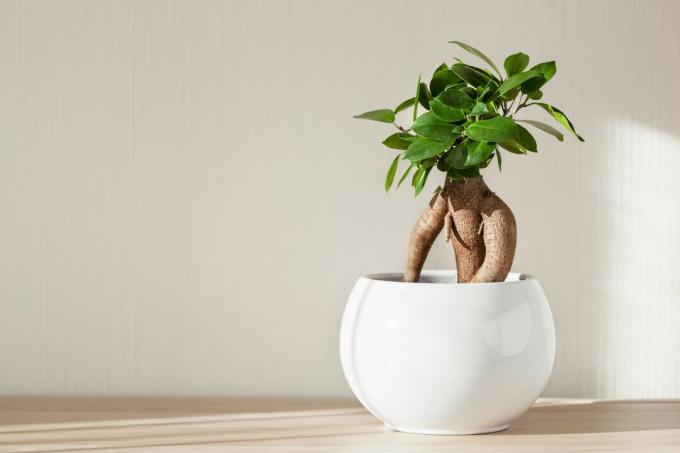
The ficus ginseng (Ficus microcarpa) is a popular type of bonsai with a modern and at the same time Far Eastern flair. With its dense and compact growth and the decorative dark green leaves, the Ficus Ginseng fits into every apartment. We will show you what you should look out for when it comes to care.
"Contents"
- Ficus Ginseng: Origin and Properties
-
Plant Ficus Ginseng
- The right location for the Chinese fig
- Approach to planting
-
Care of Ficus Ginseng
- Pour ficus ginseng
- Fertilize Ficus Ginseng
- Cut ficus ginseng
- Ficus ginseng is losing leaves: what to do?
- Wintering of Ficus Ginseng
- Propagate Ficus Ginseng
- Repot Ficus Ginseng
- Is the ficus ginseng poisonous?
Ficus Ginseng: Origin and Properties
Just as diverse as the forms that Ficus microcarpa can assume, are the synonyms by which the bonsai is known. The name we use most often is Ficus Ginseng. This name is derived from the particularly thick root of the ficus, which is shaped like a ginseng root (
Panax ginseng) is similar. Indeed Ficus microcarpa also becomes common Ficus microcarpa-Ginseng, called Chinese fig, Indian laurel or laurel fig.The bay fig originally comes from the subtropical regions of Southeast Asia and Australia. In the natural habitat, the tree reaches a height of around 30 meters. Ficus microcarpa branches naturally very strongly and is also particularly easy to cut. This results in a good suitability for cultivation as a bonsai. This includes the rearing of cuttings, a one-time strong cut and then the repeated shape cut, as well as a strong reduction in the root space. The result is a Ficus Ginseng in the size of 30 to 150 cm, as it can be purchased in the garden center. In the case of particularly small trees, the Ficus Ginseng is cut off just above the roots when it is around ten years old and a species-specific shoot is grafted onto it. The decoratively curved base of the plant is actually not a stem, but part of the root.
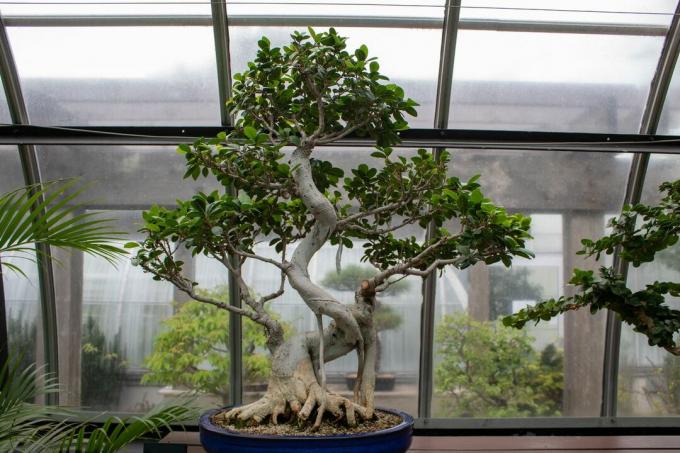
The leaves are dark green in color and have a slight sheen on the upper side of the leaf. If visible, the trunk is covered with a brown to gray bark.
As a rule, the Chinese fig does not bloom as a bonsai in an apartment. But even without flowers, the plant is beautiful to look at. If Ficus Ginseng does form flowers, they are small and inconspicuous on the leaf axils.
Plant Ficus Ginseng
As most Ficusmicrocarpa-Ginsengs are cultivated as bonsai or at least in the style of a bonsai, the planter is an important part of the appearance and proper care. As a rule of thumb you can say: The flatter the bowl, the more often it has to be poured and the more important it is to choose a high-quality and structurally stable substrate that is not collapses. And further: the smaller the planter, the weaker the Ficus Ginseng grows and the easier it is to keep it as a bonsai. This is why bonsai pots are flat and hardly offer the roots any space for further development.
If you water less and want to use normal soil, you can choose a larger bowl. This should be at least half as high as it is wide and allow the roots to develop. But keep in mind that a Ficus Ginseng in a large bowl may soon no longer be a small bonsai.
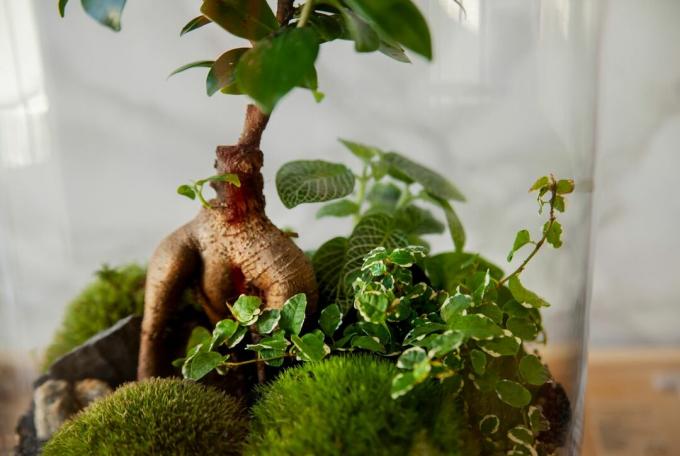
The right location for the Chinese fig
Feels most comfortable Ficus microcarpa in a bright location out of direct sunlight. A normal room temperature of 18 to 22 ° C is just right for the period between March and October until wintering. The Chinese fig cannot tolerate strong drafts or temperature fluctuations. The Ficus Ginseng is therefore also well suited as a plant in the bedroom. In midsummer, the ficus can also be cultivated outside, but only if the temperatures at night do not drop below 15 ° C and if it can be protected from direct sunlight.
Approach to planting
Since a relatively small planter is often chosen in relation to the plant, the quality and above all stability of the plant substrate is particularly important. The Ficus Ginseng needs a soil with high water storage capacity and at the same time good ventilation. A mixture of high-quality potting soil, lava gravel and Akadama soil in equal parts is recommended. A mixture of loose herb soil or seed soil, Akadama and pumice in a ratio of 2: 1: 1 is also possible.
Our Plantura organic universal soil or the Plantura organic seed and herb soil which are both peat-free and, thanks to a high proportion of coconut fiber, loose and structurally stable.
Care of Ficus Ginseng
Above all, an adapted water supply and a good supply of nutrients are important for successfully caring for Ficus Ginseng. Increased air humidity, for example through weekly spraying with lime-free water or by placing it in the bathroom, has a positive effect on the health of the Ficus Ginseng. The Chinese fig is hardly affected by plant diseases anyway. Infestation of Ficus Ginseng by pests is also rather rare.
Pour ficus ginseng
The water supply is one of the key points for successful maintenance of the Ficusmicrocarpa-Ginseng. Due to the small planter, the substrate dries out quickly, but should always be kept moderately moist. Usually the right time to water is when the substrate has dried on the surface. Rainwater is best for watering. If you don't have this on hand, mineral water is also a good alternative. Tap water containing lime is not recommended, as this can result in unsightly limescale deposits on the planter. Like your Water bonsai properly we have compiled for you in our special article.
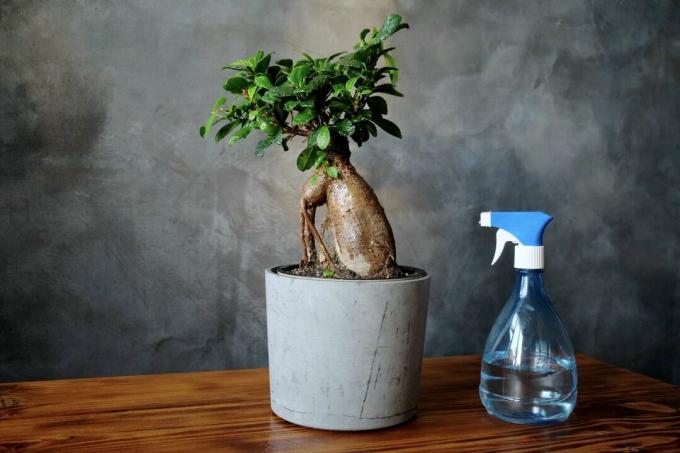
Fertilize Ficus Ginseng
Fertilizing with a liquid fertilizer is particularly important when cultivating Ficus Ginseng - as with all bonsai. Particularly in the period from March to September, due to the growth and the small amount of substrate, care should be taken to ensure a good supply of nutrients. During this time, a fertilization interval of once a week or every two weeks is very good. We recommend that you look out for a special house plant fertilizer like ours Plantura organic indoor & green plant fertilizer. More helpful tips on the subject Fertilize bonsai, can be found in our special article.
In winter, an interval of one fertilization per month for the Ficus Ginseng is completely sufficient due to the reduced growth.
Cut ficus ginseng
Regular pruning is very important when growing a bonsai. If you've opted for a pre-shaped ficus ginseng bonsai, cutting is made easy for you. As a guideline for pruning in spring, at the latest when a shoot has formed eight new leaves, it should be cut in half. If you feel that the crown is getting too big overall, the plant can also be pruned more heavily. Since Ficus Ginseng is very easy to cut, it is also forgiving to cut into perennial wood. More detailed information on the subject of "Cutting bonsai“Can be found in our article.
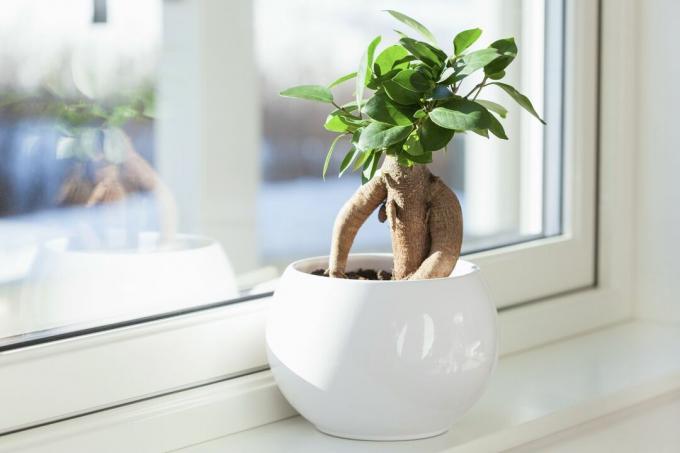
Tip: In order to direct shoots in a certain direction of growth, they can be wrapped with a wire and bent slightly - this process is called wireing or forming.
Ficus ginseng is losing leaves: what to do?
Lack of light or relocation are common causes of your Ficus Ginseng losing green leaves. If you bought your Ficus Ginseng new or moved it to a new location, moderate leaf loss is normal. This stops after a few weeks. If a lack of light could be the cause, a lighter location should be chosen and the Ficus Ginseng should be left in the new location for at least four weeks. If there is no improvement, the water supply could be the cause. Because even with dryness or waterlogging there is a loss of leaves. If the soil always feels very damp or smells musty, you should reduce the water supply. If the substrate is dry, however, it should be watered more often.
If the leaves of the Ficus Ginseng have become lighter or turn yellow, more frequent fertilizers or repotting can help.
Wintering of Ficus Ginseng
Ficus microcarpa-Ginseng can be easily overwintered. A slightly cooler room such as a guest room, stairwell or bedroom are very suitable. The optimum temperature is between 15 and 18 ° C. A bright location is also important in winter quarters. However, a window sill over a heater is not recommended due to the very dry air.

Propagate Ficus Ginseng
Although Ficus Ginseng can be propagated by cuttings, it should be noted that not small bonsai trees are created immediately, but rather large, vigorous plants. The mother plant was cut and cultivated in a very special way, which requires a certain amount of effort and a few years of patience to do it yourself.
Woody shoots about 7 cm long are cut off and placed in seed compost like ours Plantura organic seed and herb soil plugged. These shoot pieces often occur when you use your Cutting bonsai. The cuttings and the pot should be covered with foil and cultivated in a warm place with a temperature of 25 to 30 ° C. After about three weeks, the cuttings will have taken root and new buds can be seen.
Propagation via seeds is possible, but very expensive.
Repot Ficus Ginseng
The right time to repot the Ficus Ginseng has come when the substrate is completely rooted or the roots are growing in a circle on the vessel wall. This is usually the case every two to three years. In spring, the plant can then be taken out of its planter and the roots can be freed from the old earth as far as possible. The roots should be shortened slightly, but not nearly as much as is done with other bonsais. A bonsai pot, which is about 1 cm wider in diameter than the previous one, is suitable as a new planter. The new substrate can now be pressed into place with a wooden stick. In our special article on the subject of "Repot the bonsai" compiled.

Is the ficus ginseng poisonous?
All parts of the plant in Ficus Ginseng are poisonous. It is therefore important to make sure that children or pets do not swallow leaves or other parts of plants. Nausea and gastrointestinal discomfort are common symptoms.
Ficus ginseng is also toxic to pets - especially rodents, cats, and dogs - and can even be life-threatening.
When cutting and caring for the Ficus Ginseng, you should make sure that your skin and mucous membranes do not come into contact with the white sap, as this could cause skin irritation.
Also the Rubber tree belongs to the genus Ficus and is a popular houseplant. We'll show you how to properly care for rubber trees.
